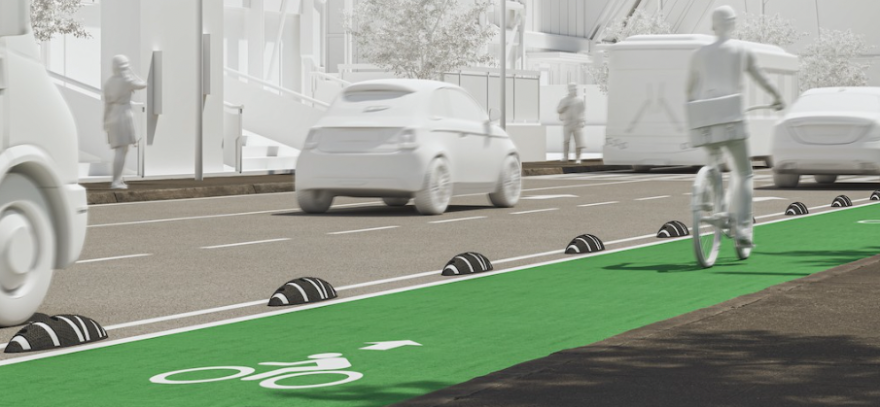Austin is set to embark on a year-long experiment along a bustling half-mile stretch of Barton Springs Road, an area best known for local restaurants like Chuy's, Baby Acapulco, Juiceland, Juliet Italian Kitchen and Green Mesquite BBQ.
The city hopes to enhance safety by reducing the number of car lanes from two to one in each direction between South Lamar Boulevard and Azie Morton Road. The construction likely won't be done until late October or early November. Then, the clock will start ticking on the 12-month trial period.

Existing bike lanes, demarcated by a single white lane, will be expanded and partially protected with a mix of flex posts and Zicla barriers, low-lying plastic dividers about the size of an armadillo made by a Spanish company of the same name.

"It's obviously a very popular area," said Lewis Leff with Austin's Transportation and Public Works Department. "If you've ever been there on a Saturday night, you see a whole lot of people on a very cramped sidewalk and a very substandard bike facility."
The city invited the public to share their thoughts on the pilot project. The consensus among supporters was clear: Barton Springs Road needs to be safer for pedestrians, cyclists and scooter riders.
Those opposing the project, however, raised concerns about potential traffic congestion. They fear that reducing lanes could result in gridlock on a crucial artery that feeds into MoPac.
To help understand the specifics of this transformative project, we'll take a step-by-step tour, starting at South Lamar Boulevard and heading westward.
At South Lamar, Barton Springs Road retains its current number of eastbound lanes. City traffic engineers believe this will help prevent a backlog of vehicles.

The aerial view below paints a clearer picture of Barton Springs Road eastbound: two left turn lanes, two straight lanes and one right turn lane. For those on bikes or scooters, navigating through this stretch will still require a careful dance with vehicles veering right onto South Lamar.

Venturing further west, the road morphs. Near Josephine Street, where the Barton Springs Saloon and Green Mesquite BBQ are located, Barton Springs Road westbound maintains two car lanes for a few yards before tapering into a single lane. Here, the bike lane would widen.

As we proceed westward, Barton Springs Road eastbound shifts from a single lane to two lanes just before Jessie Street, home to Juliet Italian Kitchen and Thom's Market.

Beyond the Pecan Grove RV Park, Barton Springs Road switches to a single-car lane in each direction. Drivers can execute U-turns at Kinney Avenue, close to the new bus stop taking shape on the southwest side of the intersection, right outside Kava Bar.

Newly constructed barriers to prevent cars leaving The Picnic food truck park from turning left will stay. Drivers heading eastbound will still be able to pull into the food truck park.

Nearing Barton Creek Road and Barton Boulevard, crews on Thursday were laying bricks for a new Capital Metro bus stop. The stop will have a shelter and a bench. The city's goal is to install two bus stops this week and two next week.

Across the street, another bus stop will be shifted away from the road to keep CapMetro buses from blocking westbound traffic when they pull over to pick up passengers.
The No. 30 Barton Creek/Bull Creek route is the only bus route traveling down Barton Springs Road. It operates every 35 minutes during peak hours.

Between Barton Boulevard and Azie Morton Road, westbound Barton Springs Road will introduce a left-turn lane for cars intending to venture south down Azie Morton. On the eastbound side, the road narrows from two lanes to one after the Barton Springs Road Bridge. The new configuration will allow the pedestrian crossing over Barton Springs Road to be shortened.

Right now, that area has two car lanes in each direction and an unprotected bike lane on both sides of the road.

Beyond Azie Morton Road, the Barton Creek Bridge will have two eastbound lanes and one westbound lane. The protected bike paths will continue into Zilker Park.

The traffic pattern shifts west of Lou Neff Road, reverting back to two car lanes in each direction.

Finally, toward William Barton Drive, bus stops will be upgraded while bike paths weave behind them.

The project's construction will be delayed by one of Austin's landmark events. The Austin City Limits Music Festival — an annual event that transforms Zilker Park into a mecca for music lovers during the first two weekends in October — will force a pause in the work starting in mid-September, when ACL loading trucks rumble into the park.
By the time ACL starts, if all goes according to plan, Barton Springs Road will have a fresh layer of asphalt and new lane markings. After ACL, crews will add the finishing touches, including the flex posts and Zicla barriers for the bike lanes. That's when the road will be reduced to one car lane in each direction.
After the 12-month trial phase starts in late October or early November of this year, the city says it will closely monitor the impact of the changes.
An update is due six months in, and by November 2024, a decision will have to be made: Keep the changes or revert back.












